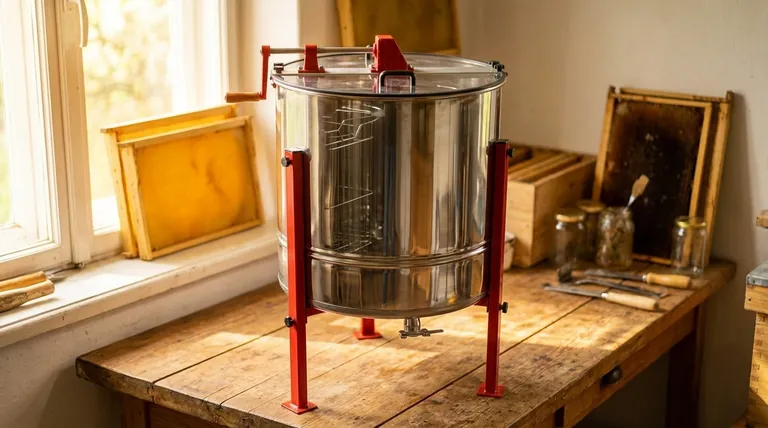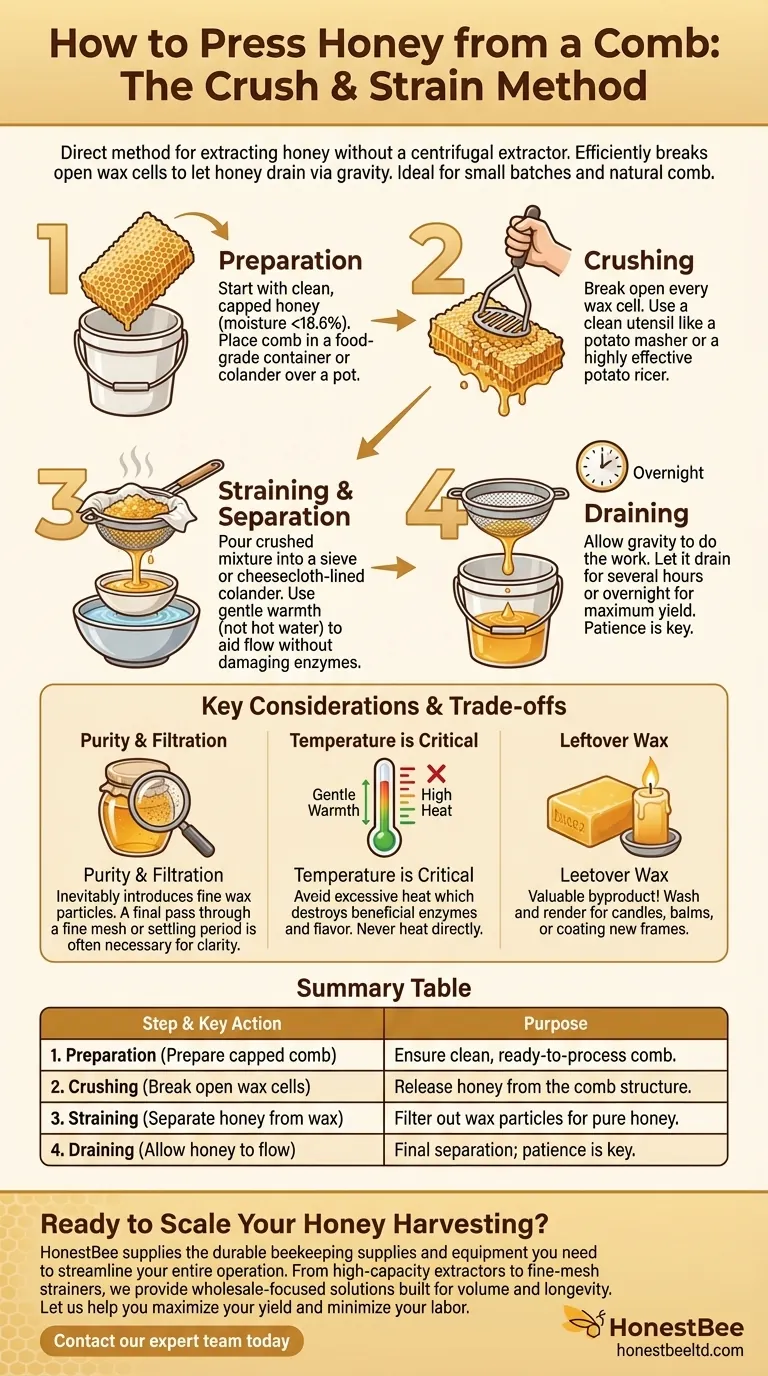To press honey from a comb, the most direct method is to cut the comb into pieces, place them in a strainer or clean mesh cloth over a bowl, and then crush the comb to release the honey. This process, known as "crush and strain," allows gravity to separate the liquid honey from the beeswax without the need for specialized equipment. For better results, you can let the setup sit overnight to allow for a slow, complete drain.
The core challenge of getting honey from a natural comb isn't about applying immense pressure, but about efficiently breaking open the wax cells and letting the honey drain. For anyone without a centrifugal extractor, the simple and effective "crush and strain" method is the industry standard.

The Fundamental Principle: Crush and Strain
For beekeepers using top-bar hives, or for anyone processing natural or cut comb, centrifugal extractors are not an option. Those machines are designed to spin intact frames and sling the honey out, preserving the comb for reuse.
The "crush and strain" method is the proven alternative. It prioritizes extracting the honey by sacrificing the comb, which is then typically rendered into a block of clean beeswax.
Step 1: Preparation
The process begins with clean, capped honey. Capped honey has been dehydrated by the bees to the correct moisture content (under 18.6%), which prevents it from fermenting.
Place your section of honeycomb into a food-grade bucket, large bowl, or a colander set over a deep pot.
Step 2: Crushing the Comb
The goal is to break open every wax cell. You can use a clean utensil, like a large spoon or a potato masher, to thoroughly crush the comb.
A potato ricer is an exceptionally effective tool for this. It allows you to both crush the comb and press the honey out in one motion, making it a highly efficient small-scale press.
Step 3: Straining and Separation
Once crushed, the mixture of liquid honey and wax fragments must be separated. Place a sieve, a colander lined with cheesecloth, or a dedicated honey strainer over a clean, food-grade bucket.
Pour the crushed comb and honey mixture into the strainer. Gravity will do most of the work, but patience is required as honey is viscous and flows slowly. Let it drain for several hours or, ideally, overnight.
A useful technique is to place the collection bowl over a larger bowl of warm (not hot) water. This gentle warmth will slightly decrease the honey's viscosity, helping it flow more freely without damaging its delicate enzymes and aroma.
Understanding the Trade-offs
The crush and strain method is effective, but it's important to understand its characteristics compared to other methods.
Purity and Filtration
This method will inevitably introduce more fine particles of wax into the honey than centrifugal extraction. A final pass through a very fine mesh screen or a settling period (where wax particles float to the top to be skimmed off) is often necessary for perfectly clear honey.
Temperature is Critical
While gentle warmth helps the honey flow, excessive heat is the enemy of high-quality raw honey. Never heat the honey directly or use water that is too hot to touch. High temperatures can destroy beneficial enzymes and alter the honey's flavor.
What to Do with the Leftover Wax
Do not discard the wax left in your strainer. This beeswax is a valuable byproduct. It can be washed and melted down (rendered) to be used for making candles, balms, wood polish, or for coating new frames for a future hive.
Making the Right Choice for Your Goal
Your approach depends entirely on your scale and what you want to achieve with your harvest.
- If your primary focus is processing a small, one-time harvest: Use a simple colander or cheesecloth set over a bowl. Crush the comb with a spoon and let it drain overnight.
- If your primary focus is hobby-level efficiency: Invest in a stainless steel potato ricer. It acts as an excellent and affordable press for small to medium batches of comb.
- If your primary focus is consuming the comb itself: Simply cut sections of the "cut-comb honey" and eat it as is. No pressing is required.
Ultimately, separating honey from its comb is a straightforward process that rewards patience and attention to cleanliness.
Summary Table:
| Step | Key Action | Tool/Equipment | Purpose |
|---|---|---|---|
| 1. Preparation | Prepare capped honeycomb | Food-grade bucket, bowl | Ensure clean, ready-to-process comb |
| 2. Crushing | Break open wax cells | Potato masher, spoon, or potato ricer | Release honey from the comb structure |
| 3. Straining | Separate honey from wax | Sieve, cheesecloth, honey strainer | Filter out wax particles for pure honey |
| 4. Draining | Allow honey to flow via gravity | Clean collection bucket | Final separation; patience is key |
Ready to Scale Your Honey Harvesting?
Whether you're a commercial apiary or a beekeeping equipment distributor, efficient honey extraction is key to your productivity and profitability. The crush and strain method is excellent for small batches, but scaling up requires robust, professional-grade equipment.
HONESTBEE supplies the durable beekeeping supplies and equipment you need to streamline your entire operation. From high-capacity stainless steel extractors and uncapping tanks to fine-mesh strainers and food-grade buckets, we provide wholesale-focused solutions built for volume and longevity.
Let us help you maximize your yield and minimize your labor.
Contact our expert team today to discuss your specific needs and discover how our wholesale equipment can benefit your business.
Visual Guide

Related Products
- 6 Frame Manual Stainless Steel Honey Extractor Beekeeping Equipment
- HONESTBEE 3-Frame Manual Acrylic Honey Extractor
- Easy Use Manual Stainless Steel Honey Press for Honey Comb
- Stainless Steel Manual Honey Press with Guard for Pressing Honey and Wax
- Plastic Hand Crank 2 Frame Honey Extractor Low Price
People Also Ask
- What is the basic principle of the honey extractor? Harness Centrifugal Force for Efficient Harvesting
- What are the key stages of honey extraction? A Complete Guide for Beekeepers
- What type of honey extractor is best? Maximize Your Harvest Efficiency with the Right Choice
- What are some tips for using a honey extractor effectively? Maximize Your Honey Yield and Protect Your Comb
- Which type of extractor is more suitable for hobbyists or small-scale beekeepers? Find the Perfect Fit for Your Apiary



















